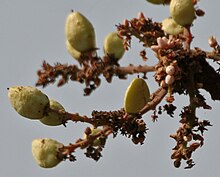Boswellia serrata: Difference between revisions
Content deleted Content added
Didn't edit Tags: Reverted Mobile edit Mobile web edit |
m Undid revision 1033682236 by 2409:4070:4D89:2F8D:7FAF:75A6:E77:FD87 (talk) Format broken. Test? |
||
| Line 8: | Line 8: | ||
}} |
}} |
||
'''''Boswellia serrata''' is a plant that produces Indian [[frankincense]]. It is also known as Indian oli-banum, Salai guggul, and Sallaki in Sanskrit.<ref>Pole, Sebastian (2013) Ayurvedic Medicine: The Principles of Traditional Practice. Singing Dragon Press. p.179</ref> The plant is native to much of [[India]] and the [[Punjab region]] that extends into [[Pakistan]].<ref>{{GRIN | accessdate=15 October 2014}}</ref> |
'''''Boswellia serrata''''' is a plant that produces Indian [[frankincense]]. It is also known as Indian oli-banum, Salai guggul, and Sallaki in Sanskrit.<ref>Pole, Sebastian (2013) Ayurvedic Medicine: The Principles of Traditional Practice. Singing Dragon Press. p.179</ref> The plant is native to much of [[India]] and the [[Punjab region]] that extends into [[Pakistan]].<ref>{{GRIN | accessdate=15 October 2014}}</ref> |
||
== Research == |
== Research == |
||
Revision as of 05:52, 15 July 2021
| Boswellia serrata | |
|---|---|

| |
| in Kinnerasani Wildlife Sanctuary, Telangana, India. | |
| Scientific classification | |
| Kingdom: | Plantae |
| Clade: | Tracheophytes |
| Clade: | Angiosperms |
| Clade: | Eudicots |
| Clade: | Rosids |
| Order: | Sapindales |
| Family: | Burseraceae |
| Genus: | Boswellia |
| Species: | B. serrata
|
| Binomial name | |
| Boswellia serrata | |
Boswellia serrata is a plant that produces Indian frankincense. It is also known as Indian oli-banum, Salai guggul, and Sallaki in Sanskrit.[1] The plant is native to much of India and the Punjab region that extends into Pakistan.[2]
Research
Boswellia serrata contains various derivatives of boswellic acid including β-boswellic acid, acetyl-β-boswellic acid, 11-keto-β-boswellic acid and acetyl-11-keto-β-boswellic acid.[3]
Extracts of Boswellia serrata have been clinically studied for osteoarthritis and joint function, with the research showing trends of benefit (slight improvement) in pain and function.[4] It has been used in Indian traditional medicine for diabetes.[5]
Gallery
-
Seeds
References
- ^ Pole, Sebastian (2013) Ayurvedic Medicine: The Principles of Traditional Practice. Singing Dragon Press. p.179
- ^ "Boswellia serrata". Germplasm Resources Information Network. Agricultural Research Service, United States Department of Agriculture. Retrieved 15 October 2014.
- ^ Dragos, Dorin; Gilca, Marilena; Gaman, Laura; Vlad, Adelina; Iosif, Liviu; Stoian, Irina; Lupescu, Olivera (2017-01-16). "Phytomedicine in Joint Disorders". Nutrients. 9 (1): 70. doi:10.3390/nu9010070. ISSN 2072-6643. PMC 5295114. PMID 28275210.
{{cite journal}}: CS1 maint: unflagged free DOI (link) - ^ Cameron, M; Chrubasik, S (22 May 2014). "Oral herbal therapies for treating osteoarthritis". The Cochrane Database of Systematic Reviews (5): CD002947. doi:10.1002/14651858.CD002947.pub2. ISSN 1469-493X. PMC 4494689. PMID 24848732.
- ^ Mehrzadi, S.; Tavakolifar, B.; Huseini, H. F.; Mosavat, S. H.; Heydari, M. (2018). "The Effects of Boswellia serrata Gum Resin on the Blood Glucose and Lipid Profile of Diabetic Patients: A Double-Blind Randomized Placebo-Controlled Clinical Trial". Journal of Evidence-Based Integrative Medicine. 23: 2515690X18772728. doi:10.1177/2515690X18772728. PMC 5960856. PMID 29774768.





